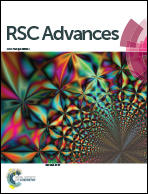The aggression behavior study of Cl− on the defect structure of passive films on copper
Abstract
The destructive role of chloride ions on the defect structure of barrier layers (bl) is vitally important for understanding the initial breakdown of passive films on metals. Here photo-electrochemical and density functional theory (DFT) were applied to investigate the influence of chloride on the defect structure of the bl in passive films. The results show a bl with a narrow band gap, in which the valence band maximum (VBM) increased upon introducing chloride into the electrolyte. DFT calculations indicate that an increase in the copper vacancy concentration, due to cation extraction at the bl/solution interface could increase the VBM while oxygen vacancy generation results in a decrease in the conduction band minimum (CBM). The combination of these results verifies the aggressive role of chloride as proposed by the Point Defect Model (PDM) where an enhancement of the cation vacancy concentration across the bl occurs in response to the absorption of Cl− into oxygen vacancies on the bl.



 Please wait while we load your content...
Please wait while we load your content...